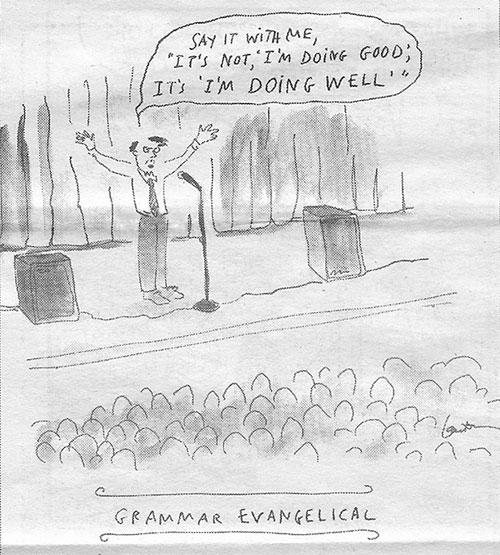|
There is/are…, It is…: We often use these constructions in communicating, perhaps without being
aware they have a grammatical classification, the expletive.
Expletives introduce clauses and delay sentence subjects. Unlike nouns and
verbs, which have well-defined roles in expression, expletives do not add
to sense or meaning; rather, they let us shift emphasis in sentences by
using "filler." For this reason,
expletives are sometimes referred to as "empty words."
There is/are
and it is are the two primary expletive clauses. Because the words
are unnecessary, sentences are tighter without them. Including the
expletive depends on whether we want to delay the subject for emphatic effect. Note the nuance and intent in the following
examples.
Sentence with expletive there:
There is
a toy airplane on the grass in the backyard.
Sentence without expletive:
A toy airplane is on the grass in the backyard.
Sentence with expletive it:
It is
a fact that he is a former Elvis impersonator.
Sentence without expletive:
He is a former Elvis impersonator. |
The sentences with expletives stress the subject instead of the verb by
postponing its normal syntactical placement. Examples of expletives for
emphasis abound in English literature. Here is but one from Samuel Taylor
Coleridge's poem "The Rime of the Ancient Mariner":
"There passed a weary time. Each throat
Was parched, and glazed each eye." |
Coleridge uses the expletive there to emphasize "weary
time" by having it follow rather than precede the verb.
Expletives' status as filler does have exceptions. For instance, when
a sentence's subject is an infinitive phrase or a that
clause, starting the sentence with the expletive it instead of the
subject sounds more natural.
Original sentence:
To train at least four weeks for the event is crucial. (less natural)
Sentence with expletive it:
It is
crucial to train at least four weeks for the event. (more natural)
Original sentence:
That she will win the local election is certain. (less natural)
Sentence with expletive it:
It is
certain that she will win the local election. (more natural) |
The expletive it also serves constructions that do not have a
concrete subject.
Examples
It is
cold outside.
It is
getting a bit loud over there.
It could
turn out to be better than we thought. |
In using and understanding expletives, we also want to identify when there and it are not operating as such. There
frequently functions as an adverb, and it is often a pronoun
referring to an antecedent.
There as expletive:
There are
six members at the meeting.
There as adverb:
Six members are there at the meeting.
It as expletive:
It is
a good idea to save money for the trip.
It as pronoun:
Saving money for the trip is a good idea. It is something we
should do. (The gerund phrase Saving money for the trip is the
antecedent to which It refers.) |
As illustrated, expletives can add style and even needed duty to our
writing. At the same time, we should include them with reserve. Like the
passive voice, they can weaken writing if used too freely. The occasional
expletive with thoughtful placement can help keep writing rich and
resonant.
| 




